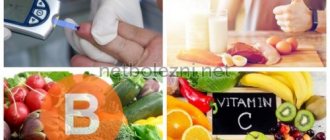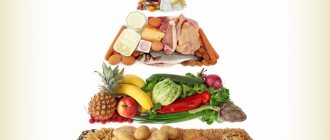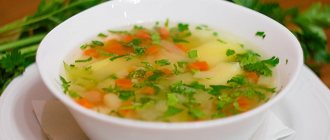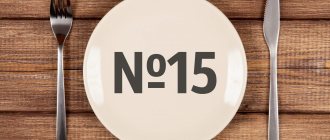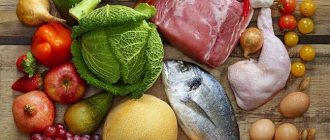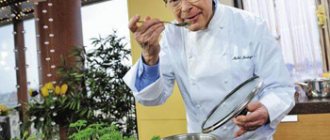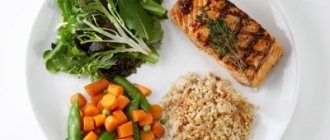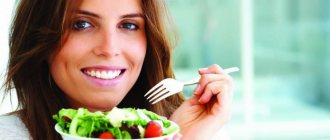“Table No. 5” is a special therapeutic diet developed in the 20-30s of the twentieth century by the founder of Russian dietetics, Manuil Pevzner. It is considered one of the best diets for people suffering from diseases of the liver, biliary tract and gall bladder. In this article we will analyze the basic principles of diet No. 5 and consider an approximate menu for this diet.
The general principles of therapeutic diets, including diet number 5, are: a balance of basic nutrients (proteins, fats and carbohydrates), a fractional diet, reducing the amount of table salt and refractory fats, abundant fluid intake and gentle cooking methods - boiling, steaming, baking. That is, the principles of proper nutrition that are familiar to all of us.
Basic rules of the dietary table No. 5
For a positive result, you must follow several rules that are provided for by this diet:
- You need to eat at least 5 times a day in small portions.
- Dishes can only be boiled, steamed, baked or stewed.
- All products that are enriched with fiber, as well as stringy meat, must first be ground.
- Cereals must be thoroughly boiled.
- Sauces are prepared without using toasted flour, but using vegetable broth or milk.
- The menu should mainly consist of products containing pectins, dietary fiber, lipotropic substances and liquids.
- Products that can cause fermentation or rotting in the intestines are not allowed.
The rules are quite strict, and most of them relate to the use of certain food products.
Cereal and potato soup
In diet number 5, it is allowed to use potatoes, but the optimal cooking option is boiling or stewing; frying the vegetable is not recommended. Soup with the addition of “second bread” is considered an ideal option for a dietary lunch; the special attractiveness of the dish is that you are allowed to slightly change the ingredients, use different types of cereals or a mixture of different grains.
Beef soup diet 5:
- Boil beef or veal (100 g) until cooked, remove from the broth, chop into cubes or tear into fibers.
- Cook cereals (oatmeal, buckwheat, brown rice or pearl barley).
- Prepare a liter of vegetable broth (simmer tomatoes, onions, carrots over low heat, strain).
- Add potato pieces to the liquid remaining after cooking the vegetables, place on low heat, and simmer for 5–8 minutes (the vegetable should be half cooked).
- Cut the parsley rhizome and carrots into small strips, arrange in one layer on a baking sheet lined with parchment, dry in the oven (sprinkle with herbs to improve the taste and aroma).
- Combine the soup ingredients and simmer, avoiding boiling, for a quarter of an hour.
Just before removing from the stove, season to taste (use salt, mild spices, chopped herbs).
Sample menu for every day of diet 5
Invites you to familiarize yourself with the approximate diet for each day that this diet provides. You can add or remove permitted products, certain products within the rules. The menu is designed for 7 days, with a total of 6 meals (breakfast, afternoon snack, lunch, snack, dinner and second dinner).
Day No. 1
- An omelette of two proteins, rice porridge + a spoon of butter, weak tea with lemon;
- Low-fat cottage cheese casserole;
- Soup from grated vegetables, soufflé from boiled meat, stewed carrots, compote;
- Weak tea with honey;
- Macaroni and cheese, still water;
- One glass of kefir (2.5% fat).
Day No. 2
- Meat cutlets with milk sauce, grated carrot salad, weak coffee with milk;
- Apple;
- Potato soup, berry jelly, stewed beets with boiled lean fish;
- Rose hip decoction;
- Buckwheat porridge with water, still water;
- A glass of kefir.
Day #3
- Low-fat cottage cheese + two tablespoons of sour cream, rice (boiled), weak tea, oatmeal with milk;
- Baked apple;
- Boiled chicken breast (150 g), rice porridge, vegetable soup, dried fruit compote;
- Fresh juice;
- Fish cutlet (steamed), mashed potatoes, milk sauce and rosehip broth;
- A glass of kefir.
Day No. 4
- Pasta and beef (grid and cook);
- Lazy dumplings;
- Vegetable soup from mashed potatoes, cabbage rolls, jelly;
- 2-3 soft fruits;
- Rice porridge with milk with a spoon of butter, weak tea;
- Kefir (1 glass).
Day No. 5
- Weak coffee with milk, low-fat cottage cheese, buckwheat with water;
- Apple (baked);
- Boiled meat soufflé, pasta and jelly;
- Weak tea with honey and milk;
- Boiled fish (150 g), mashed potatoes, vegetable salad, still water;
- Kefir (1 glass).
Day No. 6
- The tea is weak, steamed meat cutlets, boiled buckwheat;
- Carrot puree, apple jam;
- Milk soup with spaghetti, curd pudding, compote;
- Kissel (1 glass);
- Semolina porridge with milk, still water;
- Kefir (1 glass).
Day No. 7
- Weak tea with milk, rice porridge with water;
- Apple (baked);
- Steamed meat cutlets, pasta, vegetable soup, compote;
- Rose hip decoction;
- Steamed egg white omelette, cheesecakes, still water;
- Kefir (1 glass).
As you can see, the menu is quite rich, and you are unlikely to suffer from lack of food and hunger. If you do everything correctly, you can not only achieve an ideal figure and get rid of fat, but also normalize the functioning of the intestines and gastrointestinal tract.
Several delicious recipes
With diet No. 5, many foods are allowed for proper digestion and intestinal function, so it’s easy to diversify the children’s menu if desired. Basic recipes will help a busy mother cook quickly and tasty.
To read: Silhouette - oral hormonal contraceptive: features and instructions for use
White omelette
Compound:
- whites of two fresh chicken eggs,
- grated mild cheese – 10 grams,
- milk or water - 2 tbsp,
- salt - on the tip of the knife.
To prepare, melt 5-10 grams. butter in a frying pan. Mix egg whites and milk separately in a container. Pour into a bowl, cover with a lid. After 3 minutes on low heat, sprinkle with cheese, then remove after a minute. Serve with herbs and sour cream 15% fat.
Vegetable casserole
Compound:
- boiled cauliflower inflorescences – 500 g,
- cottage cheese – 50 g,
- salt,
- milk – 50 ml,
- whites of two eggs.
Beat milk, egg whites and salt. Preheat the oven to 180 degrees, grease a baking dish with butter. Place the cabbage, pour the whipped mixture over evenly, and sprinkle with cottage cheese. Cook for 20 minutes.
Main indications and how to follow the diet 5
Diagnoses for which it is advisable to follow diet table number 5:
- cholecystitis;
- liver changes caused by cirrhosis (in the absence of decompensation);
- chronic hepatitis, and not only C;
- fibrous transformations of liver cells;
- cholelithiasis.
Important: Specialists practice such therapeutic nutrition only during the period of chronic disease . When there are concomitant work disorders (ulcers, gastritis or colitis), it is impossible to follow the principles of diet menu 5.
Adhering to the principles of eating according to diet table number 5 is quite simple, although at first glance it may not seem so.
Several basic regime requirements:
- It is important to eat food in portions – 5-6 times a day;
- The total energy capacity (calorie content) of all substances received during the day should not exceed 2500 kcal;
- You need to consume at least 80 grams of protein per day with food, and the proportion between animal and vegetable proteins will be 50 to 50 (equal shares);
- Fats cannot exceed 76-78 grams, vegetable fats should be in the majority;
- Carbohydrates - the volume of their consumption is satisfied when vegetables, fruits and cereals enter the body, but only the allowed amount is approximately 400-450 grams;
- The total amount of liquid in the form of water, tea – 8 glasses;
- Salt – 8-10 g;
- The content of oxalic acid, purines and large amounts of coarse fiber should be kept to a minimum.
If you carefully monitor the amount of food and the content of these substances in it, you can significantly reduce the load on the damaged liver and improve its condition as a whole - this is what the Table 5 diet menu is aimed at.
Indications for use
This nutritional tactic is prescribed in the following cases:
- When a child is diagnosed with pancreatic diseases - pancreatitis;
- When hepatitis is diagnosed in an inactive stage;
- Children suffering from acute disorders of the digestive tract;
- When a child is diagnosed with biliary dyskinesia;
- In case of inflammation of the gallbladder - cholecystitis;
- For gastritis and gastroenteritis;
- When diagnosing cholelithiasis.
Product table
During therapeutic nutrition, not everything is allowed to be eaten. Let's consider in the form of a table what is possible and what is not allowed during diet table No. 5.
| Products | What can you eat | List of prohibited |
| Meat | Turkey, quail, chicken, lean veal, beef, horse meat, rabbit; rarely - milk sausages | Goose and duck meat, lamb, pork, any offal, canned food, lard, smoked meats and sausages |
| Fish | Perch, pike, tuna, cod, pike perch, pollock, bream, hake; rarely - salmon | Fatty fish, canned fish, smoked and salted fish |
| Seafood | Oysters are fresh; rarely – shrimp, mussels, squid | Crab sticks, any caviar |
| Cereals | Oatmeal, bulgur, buckwheat, millet, rice, semolina, couscous | All legumes, corn, lentils, barley, pearl barley |
| Bread and pasta | Bran, rye bread and dry wheat bread, dry sponge cake, crispbread, biscuits, crackers, pasta made from grade I flour | Fresh bread, puff pastry and pastry products, pasta made from grade II flour |
| Milk | Natural yogurt, kefir, cottage cheese and milk (maximum 2% fat), low-fat sour cream; rarely - mild cheese | High fat dairy products, whey, fermented baked milk, cream, cheeses |
| Eggs | Quail and chicken exclusively in the form of steam omelette | Hard boiled and fried |
| Vegetables | Beets, zucchini, carrots, pumpkin, cucumbers, potatoes, cabbage (sea cabbage, cauliflower, broccoli, Peking cabbage), celery; rarely – lettuce, bell pepper, tomatoes | Radish, onion (green and onion), eggplant, radish, asparagus, turnip, garlic, corn, parsley, sorrel, rhubarb, dill, spinach, any mushrooms |
| Fruits and berries | Pomegranate, banana, apple, avocado; limited – watermelon, pineapple, papaya | Other berries and fruits |
| Seeds and nuts | Flaxseeds | Any nuts, sesame, pumpkin and sunflower seeds |
| Dried fruits | Dried melon and papaya, raisins, prunes, dried apricots | All other dried fruits |
| Beverages | Weak black tea (with sweetener), chamomile tea, rosehip infusion, pureed compotes, non-acidic fruit drink, freshly squeezed juices diluted with water in a 1:1 ratio | Alcohol, chicory, green tea, coffee, juices, cocoa, carbonated drinks, hibiscus, tea with stevia and knotweed herb |
| Dessert | Marmalade, candies without cocoa and chocolate, marshmallows, lollipops, honey, Turkish delight and nougat without nuts; rarely – sugar, marshmallows, gingerbread, meringues, jam | Halva, chocolate, cream products, popcorn, chuk-chak, condensed milk, sherbet, waffles, ice cream, hematogen, chewing gum, muesli bars |
| Seasonings | Sauces (milk, sour cream, vegetable), rarely soy sauce | Any spices, pepper, vinegar, adjika, mayonnaise, horseradish, mustard, ketchup |
| Oil | Refined vegetable oil, butter, rarely – olive oil | Cooking fats, unrefined oil |
What is better to exclude?
- Fresh baked goods and baked goods.
All baking should be left until tomorrow and only yesterday's flour products should be eaten. Dishes made from puff pastry are prohibited.
- Salted and fatty fish.
- All industrially prepared meat products:
sausages, frankfurters and sausages, pates from duck and pork by-products. Smoked and salted pork lard.
- Soups cooked in fatty meat or fish broths.
During the cooking process, a huge amount of extractive substances are released into the broth, which can cause exacerbation of gastritis or pancreatitis in a child.
-
hard-boiled eggs
- All pickles and canned goods.
- Sour cream, cheese,
and all high-fat dairy products.
- Sour berries and fruits.
- Spicy vegetables:
sorrel, green and onions, garlic, and radishes.
- Cereal porridges:
made from corn, millet and pearl barley.
- Packaged sweet juices, strong coffee.
Therapeutic diet
The list of permitted products is quite wide. Restrictions apply only to fatty, spicy, salty and fermented foods, because such food increases the secretion of digestive juices of the pancreas and irritates the gastric mucosa. Below is a list of foods that should be limited or completely eliminated.
Table ration number 5
Group. Allowed-Forbidden
| First |
|
|
| Vegetables |
|
|
| Meat |
|
|
| Fish and seafood |
|
|
| Flour |
|
|
| Cereals |
|
|
| Milk products |
|
|
| Eggs |
|
|
| Berries and fruits |
|
|
| Dessert |
|
|
| Beverages |
|
|
Having a list of acceptable dishes and products, you can create therapeutic nutrition. It is recommended to prepare the menu in advance, at least 2 days in advance. This way you can stock up on the necessary products and select recipes, and preparing dishes will take less time. Exact adherence to all diet rules will protect against exacerbation of the disease and speed up recovery.
The fifth table is gentle on the liver. What is possible? What's not allowed?
Chronic hepatitis, gallstones, chronic cholecystitis and pancreatitis, cirrhosis in the compensation stage, biliary dyskinesia are indications for this diet.
Diet Goal #5:
- restore the function of the gastrointestinal tract;
- normalize fat metabolism;
- improve cholesterol levels and bile flow.
- nitrogen
is found in abundance in protein foods (including legumes, nuts, oils), as well as in early vegetables, watermelons with nitrates, sausages and smoked meats, which give their red color to nitrites; - cholesterol
from fatty meat (pork and offal, liver), fish (mackerel, stellate sturgeon and other varieties), eggs, fatty sour cream, cream; - purines
are metabolized into uric acid and are found in chocolate, cocoa, herring, anchovies, pork, peas, beans; - oxalic acid
is an oxalate that enhances gastrointestinal motility and is used in inorganic form in mustard, fatty meats, vinegar, chocolate and candies, cookies, cakes and ice cream; - essential oils
in onion, garlic and celery, parsley and dill, radish and radish can cause spasm of the smooth muscles of the liver; - fiber
, which stimulates the activity of the stomach and the muscles of the digestive organs.
List of products from the fifth table:
- Allowed vegetables include red cabbage, since it has 4 times less fiber than white cabbage and more carotene, cucumbers and tomatoes (not early), starchy (soft) vegetables: beets, carrots, potatoes, onions and peppers. The coarser the product, the finer it needs to be cut and ground.
- Oatmeal, buckwheat, semolina and rice cereals undergo strong heat treatment, so they are easily boiled and are suitable for nutrition. Porridges are necessary for dietary nutrition table 5.
- Ripe fruits contain more pectins and soft fibers: bananas, strawberries and other berries, apples need to be ground, pomegranate should be eaten without seeds, dried fruits should be soaked.
- Soups will fill the lunch time - only in light broths, without frying onions and carrots. Season with low-fat sour cream, chop the meat finely.
- Stew, boil and bake lean beef and chicken, rabbit. In the oven cook hake, pike perch, boil shrimp and stuff squid.
- From eggs, use mainly whites, but one yolk per day is allowed. Omelettes, casseroles, poached or pouched, as well as for stuffing and salads.
- Low-fat dairy products are a good dinner for the liver. Light cheese is allowed, which can be made at home from milk or kefir.
- Choose bread with less coarse fiber: wheat, second-grade rye, baked goods without yeast.
- Because of purines, brew teas weakly, drink juices diluted with water, homemade berry fruit drinks and compotes, decoctions of herbs and dried berries.
- Use butter and vegetable oils sparingly in porridges and salads.
- Eat sweets limited (once a day): marshmallows, marmalade, honey.
How to cook food
If you have been prescribed diet table No. 5, you should take care in advance of drawing up a sample menu for the week. One of the main components of this diet is proper processing of foods . Cooking occurs in strictly defined ways. This includes cooking, baking, steaming, and rarely stewing.
When preparing any dish, none of the ingredients are fried. Stringy meat must be chopped, and vegetables must be pureed.
Broccoli soup recipe
Before you prepare vegetable puree soup for diet table 5, you should remember a few simple requirements. Use only lean meat for the dish - it is better to take beef. It is recommended to take only bay leaf as a spice - hot spices are prohibited for most diseases. Spicy is also undesirable in a weight loss diet - such dishes increase appetite and disrupt the functioning of the digestive organs.
Soup recipe for diet 5, preparation:
- In a separate saucepan, cook beef (100 g) until half cooked, drain the liquid completely.
- Place the cabbage inflorescences in a saucepan and cook (they should become soft), you will need about 500 grams to prepare the soup. vegetable.
- Grind the meat into fibers or simply cut into small slices, put in a pan, add onion half rings, a little salt, a few bay leaves.
- Pour clean water over the meat, boil for half an hour (periodically remove the foam with a slotted spoon).
- Combine boiled cabbage and processed cheese (a pack), boiled meat, and blend with a blender.
- Add meat broth while whisking, controlling the consistency of the soup - it should be moderately thick.
When serving, sprinkle with chopped herbs (parsley, dill).
Allowed foods for diet No. 5
Despite such restrictions, the menu for every day of diet number 5 can consist of a variety of dishes. There are quite a few permitted foods within this diet plan:
- Low-fat varieties of fish and meat. In accordance with the rules of the diet, you can eat beef, chicken and turkey. However, beef is a rather stringy product, so it needs to be prepared in the form of a puree or soufflé. Chicken and turkey can be cooked whole, but should be eaten without the skin.
- Soups (vegetable, puree or cream soups). To prepare such dishes, vegetables should first be ground. You can use carrots, potatoes, pumpkin. Oatmeal, rice and semolina are excellent cereals. For dressing it is best to use sour cream or butter.
- Dairy products. If the main goal of the diet is the treatment of colitis and other gastrointestinal diseases, then it is better to use milk as one of the ingredients in dishes. It is allowed to use curd puddings or cheesecakes.
- Fruits and berries. These products can be an alternative to sweets. However, they can only be consumed in grated, boiled or baked form. It is also allowed to prepare mousses or jelly based on them. Dried fruits must be thoroughly ground.
- Honey or jam. In small quantities, these products can also be eaten instead of sugar.
- Eggs. In this diet, they can be used mainly for making protein omelettes. No more than 1 piece of yolk should be eaten per day.
- Vegetables. It is recommended to use boiled pieces of zucchini or pumpkin. You can make mashed potatoes from boiled cauliflower, grind carrots and beets.
- Butter. Used only as a salad dressing.
- Coffee, tea and juices. Sweet juices must be diluted with water beforehand. It is recommended to drink rosehip infusion or tea with lemon more often. Coffee should be weak and always have milk added.
Beverages
• Black tea with lemon or milk. You can add a little sugar or xylitol to tea. • Rosehip – always in the form of a decoction. • If individual tolerance is possible, juices can be pre-diluted with water. • Compotes from ground dried fruits and fresh fruits. • Jelly. • Jelly and fruit drinks with a little added sugar.
Soups (the main dish of the diet)
• Vegetable soups with the addition of potatoes, zucchini, pumpkin, carrots. • Cereal soups with buckwheat, semolina, rice. You can cook noodle soup. • Soup dressing: 10 g sour cream or 5 g butter. • Fruit soups. • Milk soups with pasta. • Borscht with low-fat broth. • Vegetable cabbage soup. • Beetroot soup. • Pea soup (adding small amounts of legumes). • Soup with pearl barley.
Porridges and cereals
• Viscous and pureed porridges with rice, buckwheat, oatmeal. You can cook porridge in water or in milk diluted 50% with water. • Cereal dishes: casseroles, souffles, puddings. You can add cottage cheese and vermicelli to dishes. • Pilaf with dried fruits. • Muesli that does not contain prohibited additives. • Cereals. • Bulgur, couscous. • Millet porridge. • Flax seed.
Snacks
• Vegetable salads with vegetable oil dressing. • Fruit salads can be consumed in small quantities, but only as a snack. • Zucchini caviar. • Soaked lightly salted herring. • Jellied fish after pre-cooking. • Gefilte fish. • Boiled meat in seafood salads. • Vinaigrette with the addition of permitted vegetables. • Sauerkraut, which is pre-washed to remove salt.
Meat/fish/seafood
Lean beef, veal, rabbit, chicken, turkey (all poultry without skin). Only boiled or steamed, pureed or chopped (cutlets, soufflé, puree, dumplings, beef stroganoff, soft meat in pieces); cabbage rolls, milk sausages (very limited); low-fat fish (pike perch, cod, hake, pollock, tuna), fresh oysters; shrimp, squid, mussels - limited; lightly salted salmon, salmon - limited in fat content and as a snack, not a main course; dumplings with veal or chicken (dough, lean meat, water, salt) - very limited in fat content and definitely (!) - not fried.
Pasta
• You can add any products from the list of permitted products to the paste.
Bread
• Bread made from bran or rye flour. • Dried bread made from first and second grade flour. • Rusks. • Cookies: biscuits and unsweetened dry cookies. • Dried sponge cake. • Wheat slices. • Breads that do not contain artificial additives. • Bran.
Fermented milk products, milk and milk-based products.
• Low-fat sour cream. • Mild cheeses in small quantities. • Kefir, yogurt, cottage cheese, milk, fat content of products should not exceed 2%. The maximum daily volume is 200 ml • You can use cottage cheese to make lazy dumplings, bake cheesecakes, casseroles and puddings. • Curdled milk. • Feta cheese in small quantities. • Yogurts that do not contain artificial additives.
Vegetables
• Potatoes, cauliflower and Chinese cabbage, pumpkin, zucchini, carrots, beets. These vegetables can be boiled and baked, but only consumed in grated form. • In small quantities it is allowed to include various salads in the menu, for example, iceberg, corn, romaine. • You can eat bell peppers in small portions. • Sea cabbage. • Avocado. • Tomatoes in extremely small quantities. If the disease is in the acute stage, then they are excluded from the menu. • Steamed or baked green beans. • Broccoli and celery, boiled or steamed.
Oil
• No more than 30 g of butter per day. • Refined vegetable oil (no more than 15 g per day). The oil is used only as a salad dressing. • Olive oil can be consumed in small quantities.
Eggs
• You can make an omelet from eggs or boil them. No more than 2 quail eggs per day and no more than half a chicken yolk in dishes.
Seasonings and sauces
• Fruit gravy with flour added. It is not fried in advance. • Milk, vegetable and sour cream sauces. • No more than 10 g of salt per day. • Dill and parsley. • Vanillin and cinnamon. • Soy sauce can be added to dishes in small quantities.
Sweets
• Boiled and baked fruits and berries. The main condition: they should not be sour. • Compote of dried fruits, fresh dried fruits, but in small quantities. • Jelly, jelly, mousse. • Marmalade. • Candies that do not contain cocoa and chocolate. • Jam, which is best added to tea or made into fruit juice. The jam should not be too sweet or too sour. • Sugar can be consumed in small quantities. • Dumplings with potatoes, cabbage or berries. The dough is prepared using water and flour, lightly salted. • Lollipops. • One gingerbread per day. Chocolate is prohibited. • Turkish delight and nougat, which do not contain nuts. • Soft caramels, without seeds, sesame and nuts. • Biscuit, but no more than one piece per day.
Berries and fruits
• Soft sweet apples. They can be eaten raw, baked, or ground. • Banana, but not more than 1 piece. in a day. • Mousses and jellies with added sugar substitute. • Pomegranates can be included in the menu in small quantities. Patients with hemochromatosis should not eat pomegranates. • Prunes. • Two pieces of watermelon per day. • Dried melon and papaya, dried apricots. These fruits are added to salads in small quantities. In their pure form, they are prohibited for consumption. • Fruit puree that is allowed for table No. 5.
Menu creation
In general, during the diet period it is necessary to divide meals into 5-6 meals. Let's look at what products are on the menu.
Bread
As for bakery products, baked or dried bread is acceptable. You can take rye, wheat and other types of bread, including coarse bread. Do not forget, however, that fresh bread, puff pastry, any pastry and pies are prohibited.
At the same time, you can add savory products with cottage cheese and apples to the menu, as well as give hard savory cookies and dry biscuits.
Soups
The diet can include a variety of vegetable soups, vegetarian borscht and cabbage soup, soups with cereals, beetroot soup, with pasta in vegetable broth or fruit and milk soups. In this case, vegetables and flour for dressing are not fried, but dried. Soups can be salted, but only served warm.
Pasta and cereals
You can include puddings, casseroles, semi-viscous porridges in your diet, dishes made from buckwheat porridge and oatmeal are especially good. You can prepare pilaf with carrots and dried fruits, pudding with cottage cheese and carrots, semolina, rice, and krupeniki. Boiled pasta. At the same time, pearl barley, barley and millet are excluded.
Vegetables
When dieting table 5 for children, include various types of vegetables and herbs, canned green peas, non-acidic sauerkraut, squash caviar, and ripe tomatoes in the menu. Vegetables are supposed to be either raw, boiled or stewed. They can be in the form of a salad, a side dish or as an independent dish.
Dairy products and milk
Milk is allowed in the diet; it can also be added to tea. Use sour cream, low-fat cottage cheese, yogurt, acidophilus, and mild types of cheese in your diet. You can cook lazy dumplings, puddings, casseroles, curd soufflé, omelet, curd babka, steamed cheesecakes. Vegetable oil and butter are allowed no more than 50 g per day.
Berries and fruits
Berries and fruits should be taken only sweet. From them you can already prepare jelly, compote, mousse, jelly, tea with lemon. You can offer your child jam, honey, and a little sugar in his tea. Marmalade, marshmallows, dried fruits and non-chocolate candies are also acceptable.
Beverages
Tea with milk or lemon, weak tea, tomato juice, fruit and berry juices, rose hip decoction. Cocoa, black coffee, cold drinks, including carbonated ones, are not allowed.
- Diet Table No. 10 and the corresponding menu are prescribed to patients with cardiovascular diseases (heart defects, coronary artery disease, hypertension, rheumatism), diseases of the nervous…
- Diet for obesity No. 8 involves a special menu, the purpose of which is to have a direct effect on metabolism in order to eliminate fat as much as possible. Thanks to…
- For gastritis with high acidity, the main treatment is diet. Therefore, it is necessary to pay special attention to its instructions and doctor’s recommendations. First...
- A diet for liver disease involves a specific menu that is used in the treatment of almost all diseases associated with liver function: cholecystitis, cirrhosis,…
Hello readers! Today I am writing about a very important topic for many people: the 5 table diet, what you can and cannot eat. I will present everything in a convenient visual table. I will also write a sample menu for the week for meals of 5 tables.
Prohibited foods on diet No. 5
Diet 5 for a week at home should not contain the following products:
- Meat, fish or mushroom fatty and strong broths.
- Fresh bread, buns.
- Canned and smoked products.
- Fried, chunky meat.
- Fatty fish and meats, caviar.
- Spicy and salty cheeses.
- Cottage cheese with high fat content.
- Egg dishes, except omelettes.
- Mushrooms and legumes.
- Garlic, onion, sorrel, radish and cabbage.
- Crumbly porridge.
- Chocolate and ice cream.
- Pickles and marinades.
- Black coffee without milk, soda and cocoa.
- Spices and snacks.
Tofu – 72-90 kcal, fat content up to 5%, proteins – 8 g
I’ll also say something about soybean cheese – tofu. Yes, it has the lowest fat content among all the cheeses I have listed and should be in first place, but there is one “but”: tofu promotes excessive gas formation, and therefore in case of gastrointestinal diseases you need to eat it in very limited quantities.
For the rest of the tofu there is no price. It is an antioxidant that removes dioxin, which causes cancer, from the body, and also reduces the level of “bad cholesterol”. At the same time, tofu is not just a dietary product, but a super dietary product: calorie content - 73 kcal, proteins - 8 g, fats - 4.5 g, carbohydrates - 0.8 g. So occasionally, for variety, you can indulge in tofu. Adding it to salads is a nice thing, I tell you.
To summarize: Adyghe cheese and ricotta fit best into the criteria of the fifth diet. They are not salty, not fatty, do not contain much protein and are great for breakfast. Just what the doctor ordered. Just don’t forget to count calories every day (it’s easier to do this with our calculator) and take hepatoprotectors. Like diet, it is an integral part of a liver recovery program.
How long to keep the fifth diet?
To get used to it, the patient is first transferred to diet food according to the 5 table diet menu for a week, then for five weeks. This algorithm is used for additional therapeutic effects in hepatitis C and pathological changes in the liver , the duration is usually one and a half or two years.
To ensure variety in the menu for every day according to diet 5 table, it is reasonable to calculate the list of products used during the week. It is also advisable to make preparations and think in advance what dishes should be prepared. This advice will help make your diet balanced in microelement composition, as well as save your family budget.
Diet number 5: recipe for soup with milk
Often in dietary nutrition it is suggested to prepare liquid dishes based on milk, but it should be borne in mind that dairy products often cause an allergic reaction. When dieting for weight loss, it is recommended to use milk with minimal fat content.
Step-by-step preparation of soup:
- Bring water (200 ml) to a boil.
- Add semolina (50 g) in a thin stream, stirring vigorously, and continue cooking for 8-10 minutes, without stopping stirring the mass (this will avoid the formation of lumps).
- Pour preheated milk (200 ml) into the boiling mass and continue cooking, stirring the soup occasionally.
- Bring 100 ml of milk to a boil, add a white-washed chicken egg, gradually pour the egg mixture into the pan with semolina.
- Before removing from heat, season (add a little good butter and sugar).
If there are no strict dietary restrictions, it is allowed to improve the taste of the soup with jam or thick fruit preserves.
Why do you need a diet?
Diet is used to help the body recover
The gallbladder performs an important function in the body. It accumulates bile, which is necessary for complete digestion of food. At the right moment (when eating), bile from the gallbladder enters the intestines, where the breakdown of products occurs.
After removal of the gallbladder, this process is disrupted, and bile enters the intestines not after eating, but throughout the entire time in small portions, where it can periodically stagnate.
Stagnation of bile leads to very unpleasant consequences, such as damage to the intestinal walls and the appearance of areas of inflammation. In addition, after removal of the gallbladder, the human body produces much smaller amounts of digestive enzymes that help break down food.
This means that the digestion process becomes more complicated, and the load on the organs of the digestive system increases. In order to prevent such developments, it is necessary to adhere to a specially designed diet.
Soup with dumplings and milk
In dietary nutrition, soup with dumplings cooked in milk is one of the main dishes. Children especially like it, as they enjoy eating this delicious milk treat. If the diet is aimed at burning fat deposits, it is better to avoid introducing this soup into the diet - the presence of wheat flour, butter and sugar reduces the effectiveness of weight loss.
Preparation:
- Mix one chicken egg, premium wheat flour (200 g), butter (10–15 g), replace the dough with a consistency similar to thick sour cream (if there is not enough liquid, dilute a little with milk or boiled water).
- Put a liter of milk on the fire, wait until it boils, add a little salt.
- Take the prepared dough with a spoon (about 15-20 grams each) and drop it into the boiling liquid.
- When the dumplings float to the surface of the milk and boil for 5 minutes, add small vermicelli (50–70 g) to the soup.
- Stir the milk soup, add sugar, boil until the vermicelli is ready.
Serve immediately after preparation.
